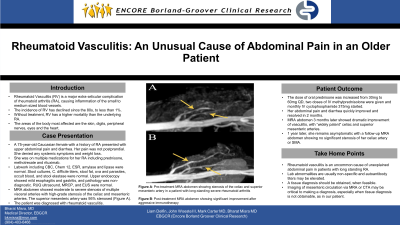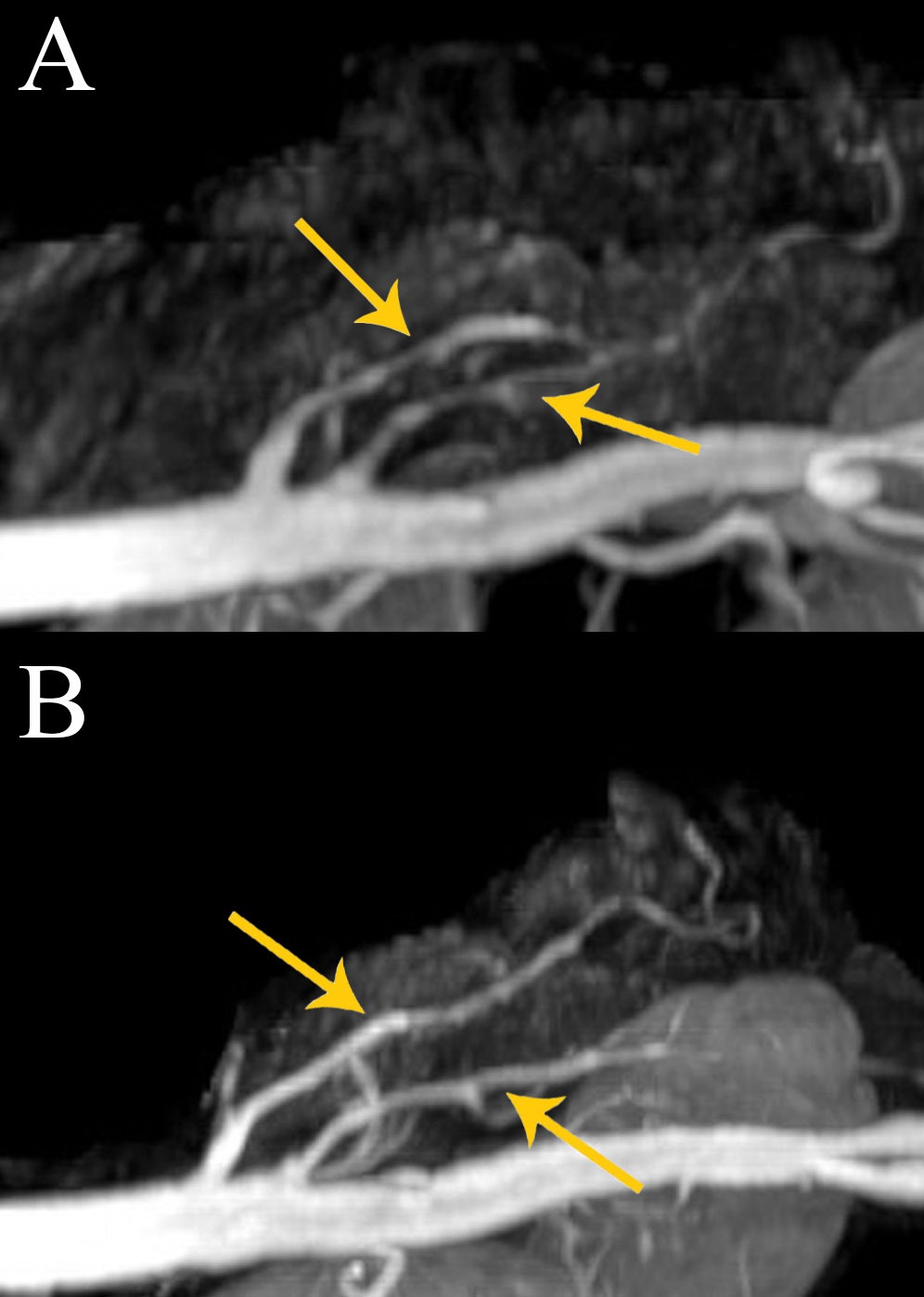Sunday Poster Session
Category: Small Intestine
P1321 - Rheumatoid Vasculitis: An Unusual Cause of Abdominal Pain in an Older Patient
Sunday, October 22, 2023
3:30 PM - 7:00 PM PT
Location: Exhibit Hall

Has Audio

Bharat Misra, MD
Borland Groover
Jacksonville, FL
Presenting Author(s)
Bharat Misra, MD1, Liam Delfin, BS2, John T. Woeste, BA2, Mark Carter, MD1
1Borland Groover, Jacksonville, FL; 2ENCORE Borland Groover Clinical Research, Jacksonville, FL
Introduction: We report a case of rheumatoid vasculitis (RV), presenting in an older patient with abdominal pain. Extensive imaging and endoscopic work up did not reveal the cause of her abdominal pain. The diagnosis was only revealed by a magnetic resonance arteriography (MRA). A timely diagnosis of RV is critical given its high morbidity and mortality without early treatment.
Case Description/Methods: A 75 year old white female with a history of rheumatoid arthritis (RA) presented with upper abdominal pain and diarrhea. Her pain was not post prandial. She denied any systemic symptoms and weight loss. She was on multiple medications for her RA including prednisone, methotrexate and rituximab. CBC, Chem 12, ESR, amylase and lipase were normal. Stool cultures, C. difficile titers, stool fat, ova and parasites, occult blood, and stool elastase were normal. Upper endoscopy showed mild esophagitis and gastritis, and pathology was non-diagnostic. RUQ ultrasound, MRCP and EUS were normal. MRA abdomen showed moderate to severe stenosis of multiple visceral arteries with high-grade stenosis of the celiac and mesenteric arteries. The superior mesenteric artery (SMA) was 95% stenosed (Figure 1A). A diagnosis of RV was made. Her rheumatologist increased her oral prednisone from 30mg to 60mg daily, gave her two doses of IV methylprednisolone, and started monthly IV cyclophosphamide (375 mg/m2). Her pain and diarrhea quickly improved and resolved by two months. An MRA three months later showed dramatic improvement of vasculitis, with “widely patent” celiac and superior mesenteric arteries and their vascular distributions. A year later, she remains asymptomatic, and a follow up MRA abdomen showed no significant stenosis of her celiac artery and SMA (Figure 1B).
Discussion: Rheumatoid vasculitis (RV) is a cause of unexplained abdominal pain in patients with long standing RA. Its incidence is decreasing and it affects less than 1% of patients with RA. Lab abnormalities are non-specific. Titers of several autoantibodies can be elevated (RF, anti-CCP, ANA, ANCA, etc.). RV affects small and medium sized vessels and can involve other organs like the skin (90%), digits, peripheral nerves, eyes, and heart. Whenever possible, a tissue diagnosis should be obtained as RA is associated with significant morbidity, and treatment requires intensive immunosuppressive therapy. As in our patient, a high index of suspicion along with imaging of the mesenteric circulation (MRA or CTA) is critical to making this diagnosis.

Disclosures:
Bharat Misra, MD1, Liam Delfin, BS2, John T. Woeste, BA2, Mark Carter, MD1. P1321 - Rheumatoid Vasculitis: An Unusual Cause of Abdominal Pain in an Older Patient, ACG 2023 Annual Scientific Meeting Abstracts. Vancouver, BC, Canada: American College of Gastroenterology.
1Borland Groover, Jacksonville, FL; 2ENCORE Borland Groover Clinical Research, Jacksonville, FL
Introduction: We report a case of rheumatoid vasculitis (RV), presenting in an older patient with abdominal pain. Extensive imaging and endoscopic work up did not reveal the cause of her abdominal pain. The diagnosis was only revealed by a magnetic resonance arteriography (MRA). A timely diagnosis of RV is critical given its high morbidity and mortality without early treatment.
Case Description/Methods: A 75 year old white female with a history of rheumatoid arthritis (RA) presented with upper abdominal pain and diarrhea. Her pain was not post prandial. She denied any systemic symptoms and weight loss. She was on multiple medications for her RA including prednisone, methotrexate and rituximab. CBC, Chem 12, ESR, amylase and lipase were normal. Stool cultures, C. difficile titers, stool fat, ova and parasites, occult blood, and stool elastase were normal. Upper endoscopy showed mild esophagitis and gastritis, and pathology was non-diagnostic. RUQ ultrasound, MRCP and EUS were normal. MRA abdomen showed moderate to severe stenosis of multiple visceral arteries with high-grade stenosis of the celiac and mesenteric arteries. The superior mesenteric artery (SMA) was 95% stenosed (Figure 1A). A diagnosis of RV was made. Her rheumatologist increased her oral prednisone from 30mg to 60mg daily, gave her two doses of IV methylprednisolone, and started monthly IV cyclophosphamide (375 mg/m2). Her pain and diarrhea quickly improved and resolved by two months. An MRA three months later showed dramatic improvement of vasculitis, with “widely patent” celiac and superior mesenteric arteries and their vascular distributions. A year later, she remains asymptomatic, and a follow up MRA abdomen showed no significant stenosis of her celiac artery and SMA (Figure 1B).
Discussion: Rheumatoid vasculitis (RV) is a cause of unexplained abdominal pain in patients with long standing RA. Its incidence is decreasing and it affects less than 1% of patients with RA. Lab abnormalities are non-specific. Titers of several autoantibodies can be elevated (RF, anti-CCP, ANA, ANCA, etc.). RV affects small and medium sized vessels and can involve other organs like the skin (90%), digits, peripheral nerves, eyes, and heart. Whenever possible, a tissue diagnosis should be obtained as RA is associated with significant morbidity, and treatment requires intensive immunosuppressive therapy. As in our patient, a high index of suspicion along with imaging of the mesenteric circulation (MRA or CTA) is critical to making this diagnosis.

Figure: Figure 1 (A, B): MRA shows stenosis of the celiac and superior mesenteric artery in a patient with long-standing severe rheumatoid arthritis (A). MRA shows significant improvement after aggressive immunotherapy (B).
Disclosures:
Bharat Misra indicated no relevant financial relationships.
Liam Delfin indicated no relevant financial relationships.
John Woeste indicated no relevant financial relationships.
Mark Carter indicated no relevant financial relationships.
Bharat Misra, MD1, Liam Delfin, BS2, John T. Woeste, BA2, Mark Carter, MD1. P1321 - Rheumatoid Vasculitis: An Unusual Cause of Abdominal Pain in an Older Patient, ACG 2023 Annual Scientific Meeting Abstracts. Vancouver, BC, Canada: American College of Gastroenterology.
